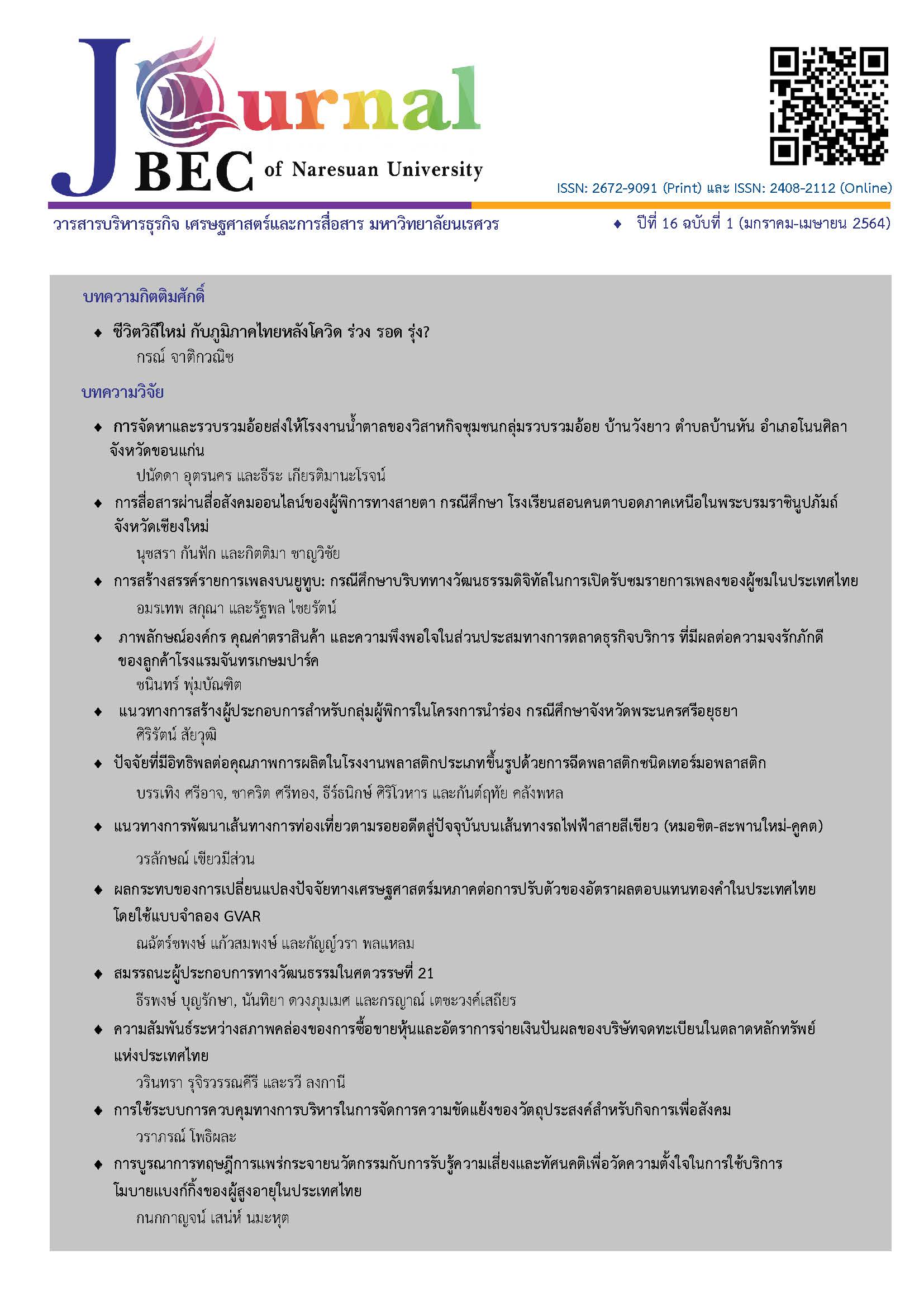รูปแบบการจัดหาและรวบรวมอ้อยส่งให้โรงงานน้ำตาลของวิสาหกิจชุมชนกลุ่มรวบรวมอ้อย บ้านวังยาว ตำบลบ้านหัน อำเภอโนนศิลา จังหวัดขอนแก่น
Main Article Content
บทคัดย่อ
การวิจัยครั้งนี้มีวัตถุประสงค์เพื่อศึกษารูปแบบการจัดหาและการรวบรวมอ้อยส่งเข้าโรงงานน้ำตาลกรณีศึกษาของวิสาหกิจชุมชนกลุ่มรวบรวมอ้อยบ้านวังยาว จังหวัดขอนแก่น สิทธิและผลประโยชน์ที่สมาชิกได้รับและการวิเคราะห์สภาพแวดล้อมทางธุรกิจของกลุ่ม ผลการศึกษาพบว่า กลุ่มมีรูปแบบการจัดหาอ้อยอยู่ 3 วิธี คือ 1) การเปิดลานรับซื้ออ้อยของหัวหน้ากลุ่ม 2) การรับซื้ออ้อยจากเครือข่ายเกษตรกรของสมาชิกบางราย และ 3) การรับซื้อบิลอ้อยจากเจ้าของอ้อยรอคิวส่งอ้อยเข้าโรงงาน เป็นต้น โดยเกษตรกรที่เป็นสมาชิกกลุ่มจะได้รับเงินสดค่าอ้อยเบื้องต้น ณ วันที่ขายอ้อย และรับเงินปันผลและผลประโยชน์อื่นร่วมด้วยเมื่อปิดฤดูกาลหีบอ้อย ในส่วนของสภาพแวดล้อมทางธุรกิจของกลุ่ม พบว่า กลุ่มได้รับภัยคุกคามจากการเข้ามาเปิดลานรับซื้อของธุรกิจรายใหม่ การแข่งขันของลานรับซื้ออ้อยรายเดิมที่อยู่ในบริเวณใกล้เคียงกัน การรอคิวขนถ่ายอ้อยเข้าโรงงานมีระยะเวลามากกว่า 2-3 วัน การปลูกพืชอื่นทดแทนพื้นที่ปลูกอ้อย เช่น มันสำปะหลัง และการปรับขึ้นอัตราดอกเบี้ยเงินกู้ของสถาบันการเงิน เป็นต้น และแนวทางที่ส่งเสริมให้กลุ่มดำเนินงานได้อย่างยั่งยืน คือ กลุ่มต้องจัดสรรผลประโยชน์ให้กับสมาชิกอย่างชัดเจนและยุติธรรม สมาชิกกลุ่มทุกคนต้องร่วมมือกันจัดหาอ้อยและรวบรวมอ้อยให้ครบตามปริมาณโควตาเพื่อให้กลุ่มสามารถดำเนินการส่งอ้อยให้โรงงานได้อย่างต่อเนื่อง และหน่วยงานที่เกี่ยวข้องควรสนับสนุนเงินทุนในระดับอัตราดอกเบี้ยเงินกู้ที่ต่ำแบบคงที่และต่อเนื่องในทุก ๆ ปี
Article Details
เอกสารอ้างอิง
NorthEastern/DocLib_Research/03_Paper_SugarcaneIndust.pdf
Bank of Thailand (Northeastern Regional Office). (2017). Step into the new context of Thai sugarcane and sugar industry. Retrieved February 12, 2018, from https://www.bot.or.th/Thai/MonetaryPolicy/NorthEastern/DocLib_Research/03_Paper_SugarcaneIndust.pdf
Boon-it, S. (2015). Supply chain management for excellence. Edit 1st. Thammasat BusinessSchool, Thammasat University: Bangkok.
Charoenying, K. and Kidsom, A. (2013). The 5 forces model and competitive advantages analysis for expanding into Republic of India: A study of Container Liner Company, Limited. MUT Journal of Business Administration, 10(1), 1-21.
Chokwarakul, K. (2018). The efficient development and productivity to raise the value added of the manufacturing industry, agriculture, “cane” in the Northeast. NRRU Community Research Journal,12(1), 181-190.
Erbkamol, N. (2007). A case study on labour replacement with a sugarcane harvester.
King Mongkut’s University of Technology North Bangkok. Nonthaburi.
Inwang, K., Inwang, S. and Wanpira, A. (2011). Community enterprise management. Phisanulok University: Phisanulok.
Kaavijan, U. (2017). Guidelines for success of community-based tourism management. SAU Journal of Social Sciences & Humanilities, 1(2), 70-79.
Kaewlor, N. and Pakseti, M. (2018). Study on cost of sugar cane production and sugarcane transportation to the factory case study: Tambon Thalung Lek, Amphoe Mueang, Buriram Province, Production Year 2017/2018. Program in Agriculture, faculty of Agricultural Technology, Buriram Rajabhat University.
Kotas, M. (2015). Key success factors for social services organization in Poland. Management. 19(2): 122-135.
Kumdum, J. and Kiatmanaroch, T. (2017). Business management of sugarcane farmer group in Banwangyoa Tambon Banhun Amphoe Nonsila Changwat Khon Kaen. Khon Kaen Agriculture Journal (Suppl.), 45 (1), 1449-1453.
Kusoncum, C. and Sethanan, K. (2012). A study of costs and returns of sugarcane production sent to the sugar mill for small-scale growers in Buakhao, Kuchinarai District, Kalasin Province. pp. 2134-2140. The Industrial Engineering Network Conference 2012 on October 17-19, 2012 at Cha-am, Phetchaburi Province.
Lalitaporn, P. (2016). Inventory management in supply chains: Analysis Design and Management. Edit 1st. Chulalongkorn University Printery: Bangkok.
Meepanya, C. and Chanthakun, J. (2014). Study on economy of sugarcane for factory, Amphoe Wichian Buri, Phetchabun Province. Thesis of Science Degree (Geography), Naresuan University.
Ministry of Agriculture and Cooperatives. (2005). Community Enterprise Promotion Act, B.E. 2548. pp. 319-327. Retrieved September 24, 2019, from https://www2.moac.go.th/ download/laws28.pdf.
Mokkhamakkul, T. (2008). Performance of measurement in logistics and supply chain. Chulalongkorn Business Review. 30(117-118): 157-165.
Office of Cane and Sugar Board. (2017). Statistics of exporting sugar to overseas, classifying by importers, reported from January-December 2016. Retrieved July 1, 2018, from http://www.ocsb.go.th/upload/cuntry/fileupload/7876-7251.pdf.
Opanukul, W., Nakwattananukul, S., Jongsukwai, K., Toonhaw, M., Tongdang, B., Santoonpitak, D., et al. (2012). Study of sugarcane harvester used in Thailand. pp. 106-115. The 13rd Thai Society of Agricultural Engineering Conference on April 4-5, 2012 at Chiang Mai Province.
Pongwanich-anan, U. (2009). Study of cost and benefit for sugar cane production, Tambon Don Chedi, Amphur Phanomthuan, Karnchanaburi Province, Crop Year 2007/2008. Master Degree of Economics in Managerial Economics, Srinakharinwirot University.
Pookhang, B., Kao-ian, S. and Potchanasin, C. (2012). Analysis of a sugarcane procurement business system in Suphan Buri Province. Kasetsart Journal (Social Sciences), 33, 253-263.
Pornbuncheidkul, S. (2018). Why the big growth business using logistics system for mainlydriving business? Edit 1st. SevenDee Book Co., Ltd.: Bangkok.
Porter, M.E. (2008). The five competitive forces that shape strategy. Harvard Business Review.86(1): 78-93.
Promchai, A. and Suwannachod, S. (2011). The success of Huaykan Community Enterprise. Local Administration Journal. 4(2): 16-29.
Promchat, P. and Jadesadalug, V. (2017). Environment analysis and strategy to create a competitive advantage in fuel briquettes from coconut shell charcoal and timber charcoal from Domnerncarbon Co., Ltd in Ratchaburi Province. Veridian E-Journal: Humanities, Social Sciences, and Arts. 10(2): 709-734.
Rooplor, R., Promtat, D. and Wongwiwitgul, W. (2013). The approach for sustainable development and growth community enterprise. RMUTP Research Journal Special Issue, The 5th Rajamangala University of Technology National Conference. 158-170.
Rungtrakulchai, R., Sukjareon, W., Avirutha, A. and Chotchaicharin, W. (2019). The study of market analysis and market development planning in Bio-Base industry: The case of Thailand. TNI Journal of Business Administration and Languages. 7(1): 75-82.
School of Management at King Mongkut’s University of Technology Thonburi. (2016). Logistics and supply chain management. Edit 3rd. A-Print And Pack Co., Ltd.: Bangkok.
Tasedam, T. (2016). Analysis of cost and benefit for sugarcane planting of agriculturists in Ban Huai Luk, Tambon Don Mon, Amphur Satuek, Buriram Province. Accountancy, Faculty of Management Science, Buriram Rajabhat University.
Wongsuwan, C. (2012). The study of capital structure of sugar cane production and logistic to the factory case study: Boasuphan Sub-District, Songpinong District, Suphanburi Province/Cultivate Year 2011/2012. Independent Study of Master Degree of Economics. University of the Thai Chamber of Commerce.
Zuzuki, P. (2009). Microfinace and financial society. The 4th of Seminar of Thammasat’s Economic. Open Book: Bangkok.


